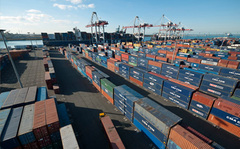- Homepage >
- Press >
- Press releases >
- Details of the press release
News detail
TRAFFIC UP 10% AT END OF SEPTEMBER
21st october 2011

September 2011 saw satisfactory traffic volumes in excess of 3.9 MT. Total traffic to the end of September (35.05 MT) was up 10% over last year.
Hydrocarbons posted a rise of 50% to 4.85 MT due to the good performance of refined products which rose 28% to 4.04 MT, as well as to crude oil volumes in the early part of the year. The port has seen six crude oil export calls and five crude oil import calls, with a total tonnage of 810 KT. Other liquid bulks show a good trend (up 34% at 1.21 MT). Liquid bulks were up 50% overall at 6.06 MT. Ore cargo figures in September were gloomy, amplifying the drop observed since the beginning of the year (8.28 MT, i.e. a shortfall of 9%). Thanks to good export levels, coal was up 22% with a volume of 5.73 MT. Grain traffic continued the excellent trend of 2010, posting an increase of 48% over 2010 with a volume of 1.51 MT. Traffic in "small" solid bulks (2,22 MT) was up 3%. Solid bulks rose 4% overall to 17.74 MT. General cargoes were up 3% at 11.24 MT. RoRo traffic was down 1% in tonnage at 8.45 MT. The number of freight vehicles was 350,000 trucks and trailers (down 4%), while passenger vehicles totalled 709,000 (up 1%) with 2.14 million passengers and drivers (an increase of 4%). Containers posted a good month of September with more than 26,000 TEU. The total number was 207,000 TEU to the end of September (up 43%), already exceeding the figure for the whole of 2010 (200,858 TEU). Full containers were up 39% at 122,500 TEU.
These reassuring traffic figures for Dunkerque-Port are reinforced by some announcements that will stimulate new volumes, including the launch by RAIL LINK EUROPE (RLE), on 21 September, of a new weekly container rail shuttle with a capacity of 80 TEU, between the Flanders Terminal of Dunkerque-Port and the Bonneuil-sur-Marne Terminal southeast of Paris. RLE's aim is to provide a combined transport service for the many shippers in the southeastern suburbs of Paris. This new link, which is scheduled to synchronise with the calls of mother ships at Dunkirk and operates overnight, already benefits from a simplified customs procedure. The operator plans very soon to increase the shuttle's frequency to two rotations a week in order to provide a more flexible service. This new offer thus represents a new stage in the strategy of extending the hinterland of France's foremost rail port.
Dunkirk is classified as the 7th port of the North Europe Range which extends from Le Havre to Hamburg. Its western port offers the deepest draughts of the Range for container ships and large ore carriers.
- Attached file
- TRAFFIC UP 10% AT END OF SEPTEMBER - PDF (146.64 Kb)
Tél : +33 (0)3 28 28 78 78 - Fax :+33 (0)3 28 28 78 77








